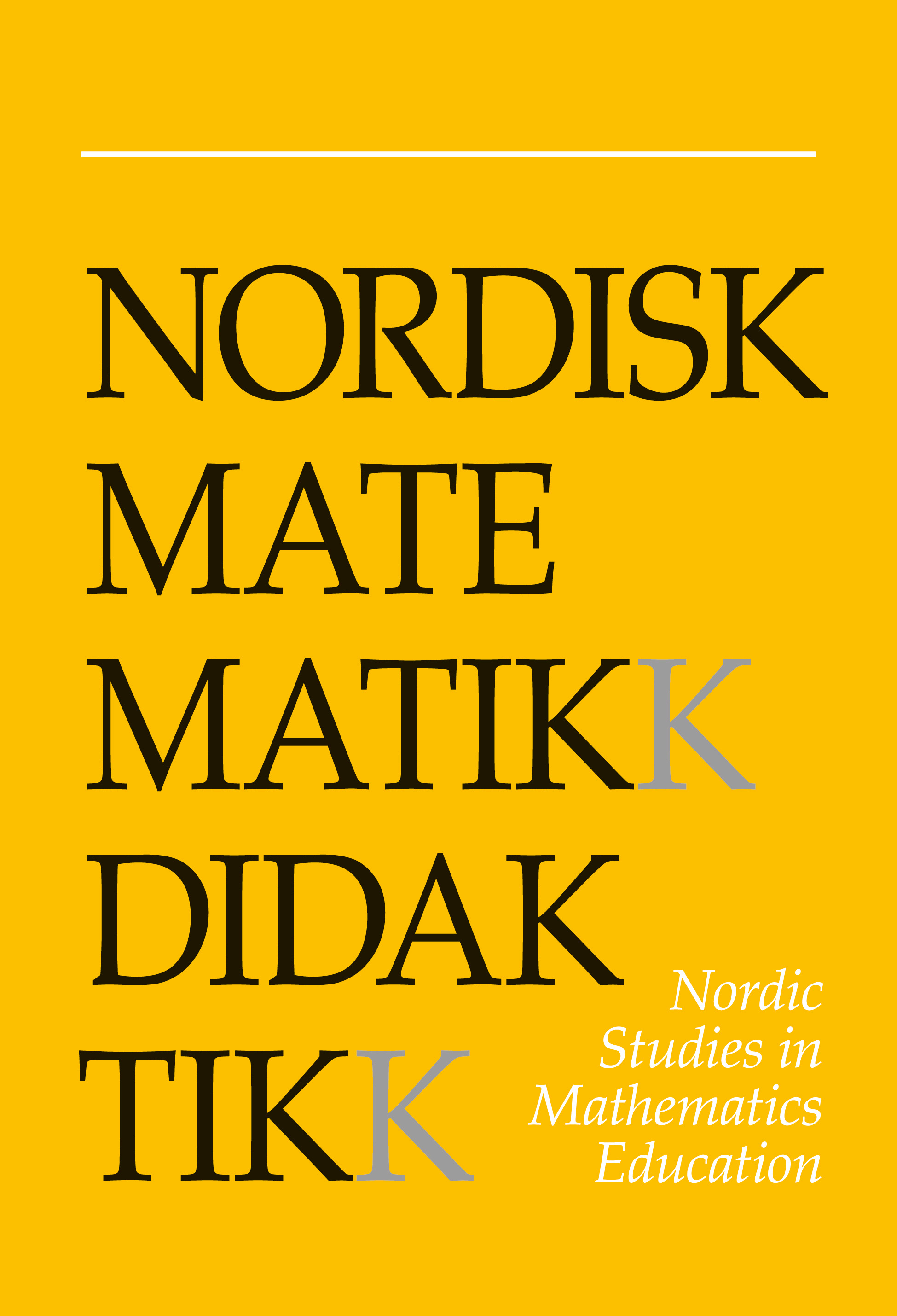Scrutinizing teacher-learner interactions on volume
DOI:
https://doi.org/10.7146/nomad.v23i2.148954Abstract
This study adds to research on volume and spatial reasoning by investigating teacher-learner interactions in the context of Lesson study. Our analysis illustrates how the mathematical object of volume is realized, and what metarules of discourse that can be observed over two iterations of a research lesson. The study unpacks the mathematical work of teaching volume in terms of discourse, and shows how an undesirable and unexpected result from the first research lesson can be attributed to the communicational work of teaching rather than to lack of skills among students.
References
Assuah, C. K. & Wiest, L. R. (2010). Comparing the volumes of rectangular prisms. Mathematics Teaching in the Middle School, 15 (9), 502-504. https://doi.org/10.5951/MTMS.15.9.0502
Battista, M. T. & Clements, D. H. (1996). Students' understanding of three- dimensional rectangular arrays of cubes. Journal for Research in Mathematics Education, 27 (3), 258-292. https://doi.org/10.2307/749365
Bjuland, R. & Mosvold, R. (2015). Lesson study in teacher education: learning from a challenging case. Teaching and Teacher Education, 52, 83-90. https://doi.org/10.1016/j.tate.2015.09.005
Chokshi, S. & Fernandez, C. (2004). Challenges to importing Japanese lesson study: concerns, misconceptions, and nuances. Phi Delta Kappan, 85 (7), 520-525. https://doi.org/10.1177/003172170408500710
Fujii, T. (2014). Implementing Japanese Lesson study in foreign countries: misconceptions revealed. Mathematics Teacher Education and Development, 16(1), 65-83.
Fujii, T. (2016). Designing and adapting tasks in lesson planning: a critical process of Lesson study. ZDM, 48 (4), 411-423. https://doi.org/10.1007/s11858-016-0770-3
Gough, J. (2004). Fixing misconceptions: length, area and volume. Prime Number, 19 (3), 8-14.
Gough, J. (2008). Just a cup. Australian primary mathematics classroom, 13(2), 9-14.
Heyd-Metzuyanim, E., Tabach, M. & Nachlieli, T. (2016). Opportunities for learning given to prospective mathematics teachers: between ritual and explorative instruction. Journal of Mathematics Teacher Education, 19 (6), 547-574. https://doi.org/10.1007/s10857-015-9311-1
Hoover, M., Mosvold, R., Ball, D.-L. & Lai, Y. (2016). Making progress on mathematical knowledge for teaching. The Mathematics Enthusiast, 13 (1-2), 3-34. https://doi.org/10.54870/1551-3440.1363
Larssen, D. L. S., Cajkler, W., Mosvold, R., Bjuland, R., Helgevold, N., et al. (2018). A literature review of lesson study in initial teacher education: perspectives about learning and observation. International Journal for Lesson & Learning Studies, 7 (1), 8-22. https://doi.org/10.1108/IJLLS-06-2017-0030
Lewis, C. & Hurd, J. (2011). Lesson study step by step: how teacher learning communities improve instruction. Portsmouth: Heinemann.
Miles, V. L. (2014). Maximizing volume with solids and nets. Mathematics Teaching in the Middle School, 20 (4), 247-253. https://doi.org/10.5951/mathteacmiddscho.20.4.0247
Mosvold, R. (2016). The work of teaching mathematics from a commognitive perspective. In W. Mwakapenda, T. Sedumedi & M. Makgato (Eds.), Proceedings of the 24th annual conference of the Southern African Association for Research in Mathematics, Science and Technology Education (SAARMSTE) 2016 (pp. 186-195). Pretoria: SAARMSTE.
Munthe, E. & Postholm, M. B. (2012). Læreres profesjonelle læring i skolen. In M. B. Postholm, P. Hauge, E. Munthe & R. Krumsvik (Eds.), Lærere i skolen som organisasjon [Teachers in school as an organization] (pp. 137-156). Kristiansand: Cappelen Damm Høyskoleforlaget.
Obara, S. (2009). Where does the formula come from? Students investigating total surface areas of a pyramid and cone using models and technology. Australian Mathematics Teacher, 65 (1), 25-33.
Olson, J. C., White, P. & Sparrow, L. (2011). Influence of Lesson study on teachers' mathematics pedagogy. In L. C. Hart, A. S. Alston & A. Murata (Eds.), Lesson study research and practice in mathematics education (pp. 39-57). New York: Springer. https://doi.org/10.1007/978-90-481-9941-9_4
Purdy, D. C. (2000). Using the Geometer's sketchpad to visualize maximum- volume problems. The Mathematics Teacher, 93 (3), 224-228. https://doi.org/10.5951/MT.93.3.0224
Sæbbe, P.-E. & Mosvold, R. (2016). Initiating a conceptualization of the professional work of teaching mathematics in kindergarten in terms of discourse. Nordic Studies in Mathematics Education, 21(4), 79-93.
Sfard, A. (1998). On two metaphors for learning and the dangers of choosing just one. Educational Researcher, 27 (2), 4-13. https://doi.org/10.2307/1176193
Sfard, A. (2008). Thinking as communicating: human development, the growth of discourses, and mathematizing. Cambridge University Press. https://doi.org/10.1017/CBO9780511499944
Stigler, J. W. & Hiebert, J. (1999). The teaching gap: best ideas from the world's teachers for improving education in the classroom. New York: Free Press.
Tabach, M. & Nachlieli, T. (2016). Communicational perspectives on learning and teaching mathematics: prologue. Educational Studies in Mathematics, 91 (3), 299-306. https://doi.org/10.1007/s10649-015-9638-7
Takahashi, A. (2013). The role of the knowledgeable other in Lesson study: examining the final comments of experienced Lesson study practitioners. Mathematics Teacher Education and Development, 16 (1), 2-17.
Tekin-Sitrava, R. & Işıksal-Bostan, M. (2014). An investigation into the performance, solution strategies and difficulties in middle school students' calculation of the volume of a rectangular prism. International Journal for Mathematics Teaching & Learning. Retrieved from http://www.cimt.org.uk/ journal/tekin2.pdf
Tekin-Sitrava, R. & Işıksal-Bostan, M. (2016). The nature of middle school mathematics teachers' subject matter knowledge: the case of volume of prisms. International Journal of Educational Sciences, 12 (1), 29-37. https://doi.org/10.1080/09751122.2016.11890409
Wadel, C. (1991). Feltarbeid i egen kultur: en innføring i kvalitativt orientert samfunnsforskning. Flekkefjord: Seek.
Wares, A. (2011). Using origami boxes to explore concepts of geometry and calculus. International Journal of Mathematical Education in Science and Technology, 42 (2), 264-272. https://doi.org/10.1080/0020739X.2010.519797
Downloads
Published
How to Cite
Issue
Section
License

This work is licensed under a Creative Commons Attribution-NonCommercial-ShareAlike 4.0 International License.



